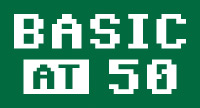BASIC Begins at Dartmouth
 At 4 a.m. on May 1, 1964, in the basement of College Hall, Professor John Kemeny and a student programmer simultaneously typed RUN on neighboring terminals. When they both got back correct answers to their simple programs, time-sharing and BASIC were born. Those innovations made computing accessible to all Dartmouth students and faculty, and soon after, to people across the nation and the world.
At 4 a.m. on May 1, 1964, in the basement of College Hall, Professor John Kemeny and a student programmer simultaneously typed RUN on neighboring terminals. When they both got back correct answers to their simple programs, time-sharing and BASIC were born. Those innovations made computing accessible to all Dartmouth students and faculty, and soon after, to people across the nation and the world.
Dartmouth's April 30, 2014, BASIC at 50 anniversary celebration kicked off with the public premiere of a documentary on the history and impact of BASIC, created by filmmakers Bob Drake and Mike Murray with Professor Dan Rockmore. The event was held from 1 to 2:30 p.m. in the Hood Museum of Art's Hood Auditorium.
The screening was followed by a discussion and Q&A session moderated by Rockmore and featuring Dartmouth computing pioneer Thomas Kurtz; Jenny Kemeny ’76 (the daughter of John Kemeny); and other Dartmouth alumni who contributed to the creation of time-sharing and BASIC as undergraduates.
- Read the original First BASIC Instruction Manual from 1964 (550 kb PDF)
- Review a cheat sheet of BASIC commands, provided by Tom Kurtz
This brief video provides an overview of the creation of BASIC and time-sharing at Dartmouth:
Origins of BASIC
In 1963, Kemeny, a mathematician who later became Dartmouth's 13th president, applied for a National Science Foundation grant to bring a GE-225 computer to Dartmouth and to build the first fully functional general-purpose time-sharing system. He got the funding, despite the grant referees' serious doubts about his plan to accomplish the work with a group of undergraduates.
Together, Kemeny, Mathematics Professor Thomas Kurtz, and a group undergraduate students, built a time-sharing system to open computer access to all at Dartmouth. At the same time, they developed a new programming language, Beginner's All-purpose Symbolic Instruction Code, or BASIC. It was ideal for introducing beginners to programming and yet could serve as a language for all applications. It worked on any computer.
Dartmouth undergraduates not only built the system, they became national leaders in computing. As part of the deal to buy the GE computer, these undergraduates built the operating system in BASIC for General Electric's version of time-sharing. Soon, colleges, high schools, and individuals all over the country could dial into high-speed digital computers and write programs using BASIC.
Click on the "i" at upper left to reveal captions for the historical photos below.
